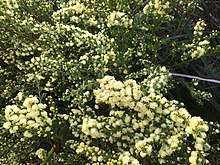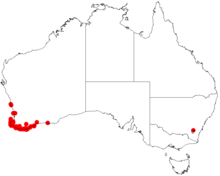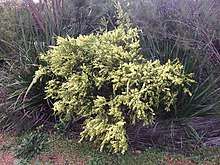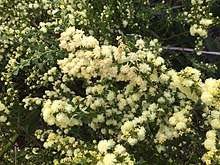Acacia littorea
Acacia littorea, also known as the shark tooth wattle,[1][2][3] is a shrub belonging to the genus Acacia and the subgenus Phyllodineae.
| Shark tooth wattle | |
|---|---|
 | |
| A. littorea flowers and foliage | |
| Scientific classification | |
| Kingdom: | Plantae |
| Clade: | Tracheophytes |
| Clade: | Angiosperms |
| Clade: | Eudicots |
| Clade: | Rosids |
| Order: | Fabales |
| Family: | Fabaceae |
| Clade: | Mimosoideae |
| Genus: | Acacia |
| Species: | A. littorea |
| Binomial name | |
| Acacia littorea | |
 | |
| Occurrence data from AVH | |


Description
The dense pungent shrub typically grows to a height of 0.5 to 3.0 metres (1.6 to 9.8 ft) and produces yellow flowers from August to November.[4] It has glabrous but prominently ribbed branchlets. The green, pungent and somewhat crowded phyllodes are ascending on the branchlets. They have an interesting obtriangular to obdeltate shape resembling a sharks tooth. The phyllodes are 7 to 17 millimetres (0.28 to 0.67 in) long and 5 to 15 mm (0.20 to 0.59 in) and sometimes larger. The simple inflorescences have globular heads containing 8 to 15 pale-yellow flowers. After flowering blackish to yellowish linear to curved seed pods that are around 6 centimetres (2.4 in) in length with a width of 2.5 to 3 mm (0.10 to 0.12 in). The pods contain shiny brown oblong seeds arranged longitudinally which are 2.5 to 3 mm (0.10 to 0.12 in) long.[5]
Taxonomy
The species was first formally described by the botanist Bruce Maslin in 1978 as part of the work Studies in the genus Acacia (Mimosaceae) – 8 A revision of the Uninerves – Triangulares, in part (the tetramerous species) published in the journal Nuytsia.[6]
The type specimen was collected by Bruce Maslin along the shoreline of Princess Royal Harbour near Albany in 1975.[5]
Several synonyms exist: Acacia dolabriformis, Acacia trapezoides, Acacia cuneata var. glabra, Acacia decipiens var. triangularis, Mimosa decipiens and Acacia praemorsa.[6]
The species is closely related to Acacia truncata.[5]
Distribution
It is native to an area in the South West, Great Southern and Peel regions of Western Australia.[4] The bulk of the population is found from Busselton east to Bremer Bay. An isolated population id found on Rottnest Island.[5] A. littorea grows mostly on coastal dunes in deep sandy soils and in limestone area.[4] It is commonly found in heath land communities and can be a dominant species.[5]
Cultivation
A. littorea is commercially available in seed form[7] or as tubestock.[8] It prefers a sunny position and well-drained soils and suits a coastal garden. The species is drought- and frost-tolerant. It is fast-growing but short-lived and suitable for erosion control or as a windbreak.[1]
See also
References
- "Acacia littorea – Wattle". Gardening with Angus. Retrieved 22 August 2018.
- Peter Llewellyn (2018). "Acacia littorea Shark's-tooth Wattle". UK Wildflowers. Retrieved 22 August 2018.
- "Survey for the Western Ringtail Possum Pseudocheirus occidentalis within part of Lots 3000 and 1523, Emu Point Drive, Albany, Western Australia" (PDF). Green Iguana. August 2007. Retrieved 22 August 2018.
- "Acacia littorea". FloraBase. Western Australian Government Department of Parks and Wildlife.
- "Acacia littorea". World Wide Wattle. Western Australian Herbarium. Retrieved 23 August 2018.
- "Acacia littorea Maslin". Atlas of Living Australia. Global Biodiversity Information Facility. Retrieved 23 August 2018.
- "Acacia littorea". Australian Seed. Retrieved 23 August 2018.
- "Acacia littoera". The Tube Nursery. Retrieved 23 August 2018.